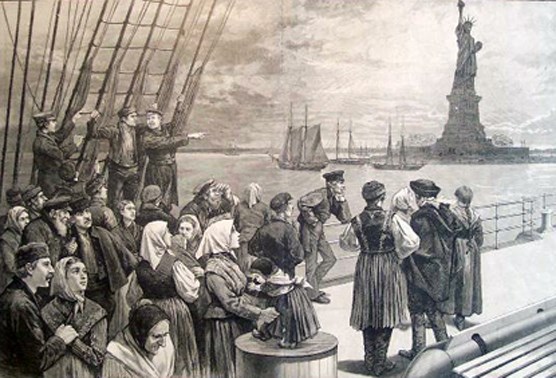The United States of America and its population are shaped by its complex history and particularly its immigration all along the years. Immigration has been essential to the development of the United States as the huge nation it is today. The discovery of this new land named the « New World », the creation of the 13 colonies in the beginning of the 17th century by people who left their country because of religious persecution, the birth of the United States as a country in 1776, the slavery period which occurred during 18th and 19th century and ended in 1865 with the ratification of the Thirteen Amendment, the wars such as the American War of Independence , the American Civil War, all those events impacted the country and led to immigration. The country has experienced African, European, and Asian immigration. The United States is a land of immigration; immigrants were and still are coming from all around the world.
This museum exhibition is going to focus on European immigration in the US on one specific period which is from the 1880s to 1920-30s. The following sources which are images, texts, excerpts of reports, videos, articles or even laws illustrate many aspects of immigration in the US at this time: the diversity of countries of origin, the economic, the social and the political consequences, the impact on the country, the reaction of American citizens but also the one of the government.
First, the term immigration means the coming of people into a country in order to live and work there. In order to be in accordance with this museum exhibition and the period it corresponds to, the term can be adapted and explained in a more specific way: immigration can be the forced coming of people into a country in order to work and help the family who stay in the country of origin, it can also be the coming of people into a country in order to find a family member who previously settled in the host country. As well immigration can mean the coming of people into a country in order to run away from wars, economic problems, or even discrimination, in other words, a better life.
From the late 19th century to the beginning of the 20th century, there were a lot of reasons to leave a country to settle in the US. The country was flourishing, the economy was good, there were opportunities for jobs, and so better living conditions. Westward expansion led to the industrial revolution which in its turn generated a rapid economic growth and a massive immigration. A period called the “Gilded Age” began during the 1870s. The wages were higher than in other countries especially than in Europe and so millions of immigrants came in the US during but also after this period. Between the 1880s and the 1920s, millions of people from diverse countries such as Italy, Poland, Germany, and Greece immigrated to the US. In the late 19th century, the arrival of millions of immigrants who were looking for jobs, better wages or their family members increased the wealth inequalities in the country and helped to create a more urbanized America. Many of those immigrants lived in poverty. Immigrants also endured forced assimilation nicknamed “Americanization”. They had to assimilate what was considered as the dominant values and ideals of the US at this period. For example, all immigrants who worked for Ford had to learn English language and besides their habits at home or in the public sphere were spying in order to make them adopt an American way of life and forget about their country of origin background and culture. We can qualify this custom by the term Cultural Genocide also employed when Native American endured the forced assimilation. In 1914, one of the most powerful examples of Americanization happened, the Melting Pot of the English School became compulsory for workers. The First World War that occurred in Europe affected European immigration during the beginning of the 20th century. Between 1870 and 1920, 25 million Europeans came to the US, 13 million of them came between 1901 and 1914. Ellis Island and Angel Island were the two immigration inspection stations in the early 20th century. While European immigration and immigration from another continent such as Asia increased, the country was changing. In 1920, 1/7 of the population was foreign-born. In Detroit, a city very urbanized, there was a huge Polish community of immigrants but also Germans, Russians, Italians. This massive immigration had many consequences on people’s lives. The conditions of immigrants were not as good as they hope to be, some never found their families, some did not find the job they needed to, a lot of immigrants were very sick. The fact that they were living in insalubrious, dangerous and crowded tenements was a deep disillusionment, the infant mortality rate was very high and a lot of immigrants remained poor. The US government reacted and handled the situation with different measures and laws such as the Immigration Restriction Act 1924 which slowed and limited the arrival of immigrants in the US by the use of a national origins quotas.
The following documents allow a better understanding of how people arrived in the US, how they lived during this period, how the US government reacted to the massive arrival of immigrants, what immigration provided to the US nation, what economic changes occurred, what laws and policies were created and more again.

An illustration of immigrants on the steerage deck of an ocean steamer passing the Statue of Liberty from Frank Leslie’s Illustrated Newspaper, July 2, 1887.
National Park Service, Statue of Liberty NM
